MLC Announces 2025 Manufacturing Leadership Award Winners

The NAM’s digital transformation division has announced the winners of this year’s Manufacturing Leadership Awards, accolades given to the most outstanding companies, teams and individuals leading manufacturing into the next era.
What’s going on: The Manufacturing Leadership Council named Celanese as its Large Enterprise Manufacturer of the Year, Pure & Gentle, Inc. as the winner in its Small-Medium Enterprise Manufacturer of the Year category and Besu Alemayehu of Merck & Co., Inc. as its 2025 Manufacturing Leader of the Year.
- The winners were announced last week at the MLC’s 2025 Manufacturing Leadership Awards Gala in Marco Island, Florida. It was the culmination of Rethink: Accelerating Digital Transformation in Manufacturing, the organization’s flagship event focused on strategies that advance digital transformation in manufacturing operations.
Why they were picked: Global chemistry company Celanese was chosen owing to its many achievements in digital transformation, including an artificial intelligence-powered digital platform that increases employee productivity and improves decision-making.
- Personal care product manufacturer Pure & Gentle won in its category for use of digital technology to monitor and boost sustainability, as well as for its creation of a work culture that fosters high levels of employee engagement.
- Merck Senior Vice President of Digital Manufacturing and Chief Digital and Technology Officer Alemayehu was recognized for leading digital initiatives that have increased business value and for partnering with senior leadership across the company in key functions.
There’s more: The award ceremony included a memorial tribute to former Lexmark Chief Sustainability Officer John D. Gagel, also a former member of the MLC Board of Governors, recognizing his lasting contributions to manufacturing and transformational leadership.
Our take: “The winners of the Manufacturing Leadership Awards represent the kind of bold and innovative thinking that will propel our industry into the future,” said NAM President and CEO Jay Timmons.
- “Every project and individual recognized in the Manufacturing Leadership Awards represents movement toward a future state of Manufacturing 4.0,” said MLC Founder, Executive Director and Vice President David R. Brousell.
Read more: See a full list of this year’s winners and finalists here.
Merck, Celanese and Pure & Gentle Named Top Winners in Manufacturing Leadership Awards Competition
Marco Island, Florida – The Manufacturing Leadership Council, the digital transformation division of the National Association of Manufacturers, last night announced the winners of the annual Manufacturing Leadership Awards. The MLC named Merck & Co. Senior Vice President, Digital Manufacturing and Chief Digital and Technology Officer Besu Alemayehu the 2025 Manufacturing Leader of the Year. By leading digital initiatives that drive business value and partnering with senior leaders across key functions, Alemayehu has guided Merck’s manufacturing operations toward a digital-first business model successfully.
The MLC named Celanese the Large Enterprise Manufacturer of the Year in recognition of its achievements in digital transformation, including an AI-powered digital platform that boosts worker productivity and improves decision-making. The MLC named Pure & Gentle the Small/Medium Enterprise Manufacturer of the Year for its use of digital technology to track and improve sustainability practices and for excellence in developing a high-performing business culture with a high level of employee engagement.
“The winners of the Manufacturing Leadership Awards represent the kind of bold and innovative thinking that will propel our industry into the future,” said NAM President and CEO Jay Timmons. “Manufacturers are using the latest cutting-edge technologies to strengthen our economy, improve business processes and, ultimately, better the lives of Americans across the country. These leaders understand the vast potential of Manufacturing 4.0 technologies, and we are proud to recognize them for their best-in-class leadership.”
The award ceremony also featured a memorial tribute to John D. Gagel, former chief sustainability officer at Lexmark and former member of the MLC Board of Governors, in recognition of his lasting contributions to the industry and transformational leadership.
The gala took place the evening of June 18 at the JW Marriott Marco Island Beach Resort and was the closing event for Rethink: Accelerating Digital Transformation in Manufacturing, the MLC’s flagship event on strategies to advance digital transformation in manufacturing operations.
“Every project and individual recognized in the Manufacturing Leadership Awards represents movement toward a future state of Manufacturing 4.0,” said MLC Founder, Executive Director and Vice President David R. Brousell. “Digital has become a must-have, and the cohort that is demonstrating digital leadership today will be reaping the competitive rewards tomorrow.”
Manufacturing Leadership Award finalists and winners are determined by a distinguished panel of judges with significant industry expertise and experience. The judges also conferred honors on the following category winners:
Artificial Intelligence Vision and Strategy
Celanese
Business Model Transformation
ArcelorMittal
Collaborative Ecosystems
Humtown
Whirlpool
Digital Supply Chains
Flex
Engineering and Production Processes
GM Defense
Enterprise Integration and Technology
Celanese
General Motors
Operational Excellence
Thermo Fisher Scientific
Sustainability and the Circular Economy
Niron Magnetics
Transformational Business Cultures
Pure & Gentle
Digital Transformation Leadership
Besu Alemayehu, Merck
Jim Wetzel, NxGen Group
Next-Generation Leadership
CisLee Trost, CertainTeed
Women in Digital Transformation
Giovanna Benetti, IBM
Renee Sherry, General Motors
Manufacturer of the Year – Small/Medium Enterprise
Pure & Gentle
Manufacturer of the Year – Large Enterprise
Celanese
Manufacturing Leader of the Year
Besu Alemayehu, Merck
The 2026 Manufacturing Leadership Awards will open to nominations on Sept. 15, 2025. For more information about the awards, visit https://manufacturingleadershipcouncil.com/leadership-awards/.
-MLC-
Founded in 2008 and now a division of the National Association of Manufacturers, the Manufacturing Leadership Council’s mission is to help manufacturing companies transition to the digital model of manufacturing by focusing on the technological, organizational and leadership dimensions of change. With more than 2,500 senior-level members from many of the world’s leading manufacturing companies, the MLC focuses on the intersection of advanced digital technologies and the business, identifying growth and improvement opportunities in the operation, organization and leadership of manufacturing enterprises as they pursue their journeys to Manufacturing 4.0.
Welcome New Members of the MLC June 2025
Introducing the latest new members to the Manufacturing Leadership Council

Learn more about MLC membership.

Keith Belevender
VP Operations, HSEQ (Americas)
SAF-Holland
![]()
https://safholland.com/us/en/
![]()
https://www.linkedin.com/in/keith-belevender-1831981/

Ger Carmody
Senior Vice President, Global Pharmaceutical Operations & Operational Excellence
Merck & Co., Inc.
![]()
https://www.merck.com/
![]()
https://www.linkedin.com/in/ger-carmody-62766516/

Josh Chou
Chief Supply Chain Officer
McCormick & Company

https://www.mccormick.com/
![]()
https://www.linkedin.com/in/josh-chou-47a1897/

Ty Hutchens
COO
Hutchens Industries

https://www.hutchensindustries.com/
https://www.oemoffhighway.com/drivetrains/press-release/10733989/hutchens-industries-announces-personnel-changes

Hugo Alberto Gomez Sierra
CEO
Condumex
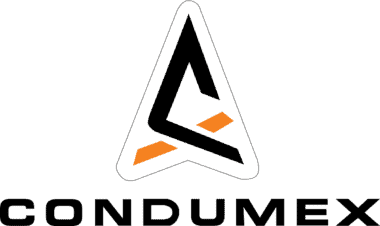
https://condumexinc.com/
![]()
https://www.linkedin.com/in/hugo-gomez-a2370011/

Mikell Taylor
Chief Autonomous Robotics Technologist
General Motors

https://www.gm.com/
![]()
https://www.linkedin.com/in/mikelltaylor/
Decarbonizing Scope 3 Emissions through Circular Strategies

Circular economy strategies offer potential benefits and opportunities to decarbonize scope 3 GHG emissions.

TAKEAWAYS:
● As companies accelerate their decarbonization journeys, Scope 3 emissions often present a challenge.
● Although Scope 3 is often the largest portion of a company’s carbon footprint, Scope 3 decarbonization levers are more difficult to identify and implement.
● Circular economy has emerged as an opportunity for the activation of meaningful decarbonization levers across the value chain.
Scope 3 greenhouse gas emissions originate from assets that businesses use that are not directly owned or controlled by the organization. Also known as value chain emissions, they emerge from corporate supply chains, transportation, and product usage or disposal. For many businesses, Scope 3 emissions represent the largest source of GHG emissions, averaging 75% of total emissions, according to CDP, a global non-profit that runs an independent environmental disclosure system for companies, capital markets, cities, states and regions. However, measuring and reducing these emissions pose significant challenges for organizations due to unreliable data and limited operational control over activities across their extended value chains.
Despite these hurdles, the pressure for companies to accurately calculate, disclose and reduce Scope 3 emissions has intensified. Key drivers include recent regulations such as the European Union’s Corporate Sustainability Reporting Directive (CSRD), the International Sustainability Standards Board (ISSB) and actions being taken in California and elsewhere. Companies are increasingly focused on submitting science-based reduction targets and credible climate transition plans, which has led to greater attention on Scope 3 emissions.
The Greenhouse Gas Protocol defines 15 categories of Scope 3 emissions; this article focuses on categories 1 (purchased goods and services), 11 (use of sold products) and 12 (end-of-life treatment of sold products), highlighting opportunities for GHG reduction through circular economy initiatives.
The Circular Economy’s Potential
The circular economy is a transformative approach that reimagines business interactions to create long-term value while promoting economic growth and ecological impacts. Circular strategies have significant decarbonization potential, with some models estimating a 56% reduction in emissions compared to traditional practices. Additionally, it is estimated that the circular economy could unlock $4.5 trillion in economic opportunities by 2030. However, its potential remains largely untapped, particularly concerning Scope 3 emissions.
Category 1: Purchased goods and services
Category 1 emissions encompass all upstream emissions from the production of products purchased by a company. A major challenge in managing these emissions is obtaining reliable supplier-specific data.
For companies using spend-based or average-data methodologies, the primary decarbonization lever is reducing spending with high-emitting suppliers. Those with access to supplier-specific data can engage suppliers directly to reflect emissions reductions across the value chain.
Circular strategies for decreasing Scope 3 Category 1 emissions:
- Circular procurement: This strategy seeks to close energy and material loops in supply chains while minimizing waste. Companies can prioritize suppliers that demonstrate circularity, such as those using circular design principles or offering take-back schemes. By incorporating circularity metrics in supplier evaluations, companies can shift spending toward suppliers with better circular performance.
- Supplier engagement: Engaging suppliers is crucial for driving meaningful change across the value chain. Companies can enhance supplier capacity through education on circular design principles and collaboration on circular material R&D. This approach can help reduce emissions from new product production and lower the carbon intensity of manufacturing processes.
Category 11: Use of sold products
Category 11 emissions arise from the use of goods and services sold by a company, including Scope 1 and 2 emissions of end users. These emissions can be divided into direct and indirect use-phase emissions, with the majority stemming from direct use.
Circular strategies for Category 11 emissions:
- Enhancing product efficiency: Improving product efficiency can be achieved through lightweighting, simplifying materials, and enhancing energy efficiency. For example, using lighter materials in automobiles improves fuel efficiency and reduces emissions.
- Utilizing renewable energy: Supporting the transition to clean energy sources, such as electrification of vehicles, can significantly reduce emissions. Electric vehicles (EVs) produce lower emissions, especially when powered by renewable energy. Electrification of passenger vehicles has increased over the last few years with a projected 20 million EVs by 2030.
- Modular design: Designing products for easy repair and remanufacture extends their lifecycle. Modular design allows for upgrades and customization, which can reduce energy consumption over time.
Category 12: End-of-life treatment of sold products
Category 12 emissions result from the disposal and treatment of sold products at the end of their life. To reduce these emissions, companies can focus on two main levers: reducing the mass of sold products and increasing the proportion of waste that is recycled.
Circular strategies for Category 12 emissions:
- Reuse: Companies are exploring reusable packaging to decrease the mass of materials sent to landfills. Standardized containers can facilitate this strategy, aligning with product-as-a-service models.
- Recycling: Implementing recycling strategies can redirect waste from landfills to recycling streams. The automotive industry, for example, has established take-back programs for used cars and collaborates on recycling lithium-ion batteries.
Looking ahead to a low-carbon economy
Circular strategies provide effective decarbonization levers across Scope 3 categories 1, 11 and 12. As pressure mounts for companies to decarbonize, strategies such as reuse, remanufacture, supplier engagement and enhanced modular design offer actionable steps to navigate the “Scope 3 dilemma.” By leveraging these strategies, businesses can contribute to a low-carbon economy while unlocking new opportunities for growth. M
The views reflected in this article are the views of the author(s) and do not necessarily reflect the views of Ernst & Young LLP or other members of the global EY organization.
About the author:

Mark Weick is Managing Director, Climate Change and Sustainability Services, at Ernst & Young LLP
Building a Practical Sustainability Management System for Manufacturers
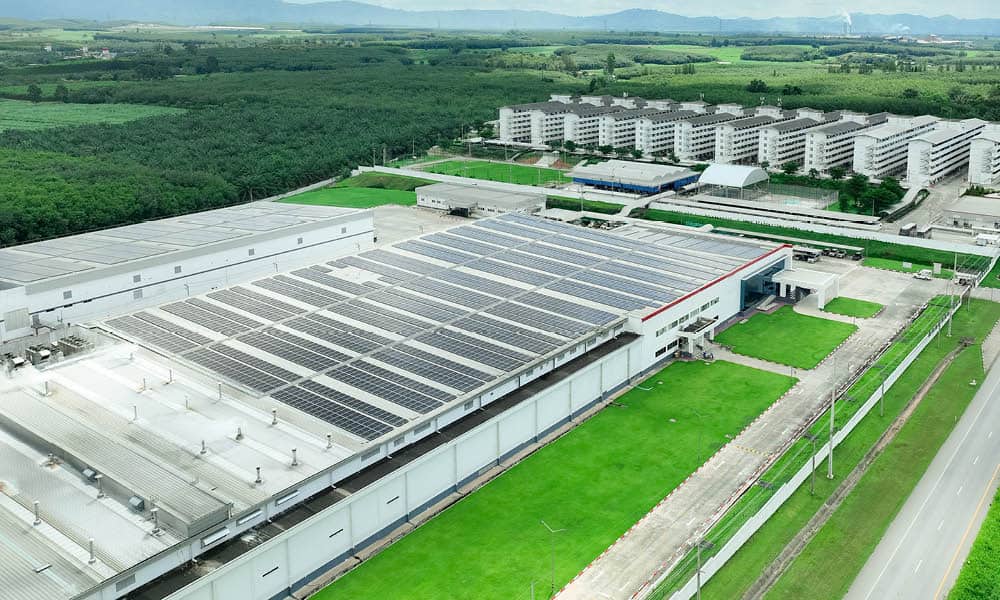
Success with sustainability requires a new, strategic way of thinking about and managing the business.

TAKEAWAYS:
● Becoming a sustainability-driven organization requires more than reports and projects. A new operating model is needed that provides workers with real-time information, guidance, and feedback.
● The need for sustainable manufacturing is accelerating and those who fail to adapt risk losing out in the marketplace.
● Sustainability needs to be embedded into daily operations and decision-making across the organization.
Sustainability is no longer a niche initiative or compliance obligation; it is a strategic imperative and a core approach to how a company is run. Yet, for many manufacturers, especially small to mid-sized enterprises (SMEs), sustainability can feel abstract or even inaccessible. The Sustainability Management System (SMS) framework was developed to address this challenge directly: to provide a clear, practical, and actionable approach for manufacturing leaders to embed sustainability into the heart of their business operations.
The Challenge: Bridging Strategy and Action
Despite growing interest in Environmental, Social, and Governance (ESG) initiatives and mounting pressure from investors, customers, and regulators, many manufacturers struggle to move from intent to execution. Traditional models like ISO 14001 provide environmental management foundations, and ESG reporting frameworks help with disclosures, but neither fully address the totality of how the business operates — from the factory floor and R&D labs to suppliers and customers.
The SMS framework, developed by the author of this article, is designed to fill that gap. Inspired by the structure of a Quality Management System (QMS), it incorporates sustainability into operational management in a way that is:
-
- Integrated with existing workflows
- Tailored to manufacturers
- Focused on continuous improvement
- Grounded in business outcomes.
The Core Philosophy of SMS
At its heart, the SMS emphasizes that sustainability is not an add-on; it is a way of managing the business differently. Instead of viewing sustainability as a set of isolated projects or compliance hurdles, SMS positions it as a strategic lens through which every decision is evaluated. This shift enables manufacturers to:
- Identify risks and opportunities across the value chain
- Strengthen relationships with employees, customers, and communities
- Innovate more effectively through circularity and resource efficiency
- Align with evolving global standards and stakeholder expectations
To achieve this, the SMS follows a structured approach that builds from foundational readiness to systemic transformation.

SMS Structure: From Foundations to Maturity
The SMS is organized around five key phases:
- Strategic Commitment: Aligning leadership and articulating a sustainability vision linked to business objectives. Without clear commitment, change remains superficial.
- Cultural Readiness: Assessing and shaping the organizational mindset required for lasting transformation. Tools such as maturity models and values assessments can help uncover hidden resistance or enablers.
- System Design: Developing governance structures, roles, and processes that embed sustainability into daily operations, similar to how QMS, MES, or ERP systems are implemented.
- Execution and Improvement: Using continuous improvement cycles to pilot, scale, and refine sustainability initiatives. This includes tracking KPIs that go beyond compliance to include innovation, resilience, and employee engagement.
- External Engagement: Connecting the SMS to broader ecosystems, certifications (e.g., COSIRI), and reporting frameworks to enhance credibility and impact.
This structured path supports organizations in moving from reactive compliance to proactive leadership.
Integrating COSIRI: Measuring What Matters
To support transparency and measurement, the SMS incorporates the COSIRI (Cognitive Sustainability Readiness Index) framework as a benchmarking tool. COSIRI provides a robust, nine-pillar and 24-dimension structure to evaluate sustainability maturity across multiple domains, including strategy, people, innovation, and operations.
This integration allows companies to:
- Identify priority focus areas
- Track progress over time
- Communicate clearly with stakeholders
- Align internal capabilities with external expectations
COSIRI is particularly valuable because it is designed for manufacturers and resonates with the realities of industrial operations.

The Handshake Model: Reframing Change
A key insight emerging from this work is the need to move beyond traditional change management approaches. Too often, organizations rely on the “stick” (punishment) or the “carrot” (incentives) to drive sustainability adoption. The SMS proposes a third approach: the “handshake.”
The handshake represents a mutual commitment to shared value. It reflects the idea that change is not something we do to people, but something we do with them. By building a sense of co-agency, companies foster:
- Trust
- Engagement
- Purpose-driven behavior
- Long-term cultural alignment
This shift is essential in a BANI (Brittle, Anxious, Nonlinear, Incomprehensible) world where resilience depends on adaptability and connection. For example, implementing solar panels can be moved from a facilities project to a values-driven, community project. Instead of defining the project as “solar panels” it can be defined as “become net-positive energy consumers.” Framing the goal as becoming net-positive invites new relationships with the local community — for instance, by donating excess energy to those in need.
Why This Matters Now
Global trends in policy, consumer behavior, and investment are rapidly accelerating the need for sustainable manufacturing. At the same time, manufacturers in the United States face unique risks. Many leaders from growth markets around the world are embracing a new calculus for prosperity, one grounded in safety, peace, and shared well-being. If U.S. manufacturers fail to adapt, they risk being outpaced not just on cost or quality, but on relevance.
This is not a call for idealism, but for strategic realism. By embedding sustainability into how decisions are made, manufacturers can unlock innovation, strengthen their competitive advantage, and ensure long-term resilience.
Conclusion: A Call to Leadership
The Sustainability Management System is not a silver bullet. It is a toolset, a mindset, and a framework for doing business better. It gives manufacturing leaders a path forward that is both visionary and grounded in the practical realities of day-to-day operations.
For those ready to lead, the SMS offers a way to bridge the gap between good intentions and great results. M
About the author:

Steven Moskowitz, Ph.D. is Founder & Principal Advisor @ Industry 4ward LLC and Senior Content Director at the Manufacturing Leadership Council. He can be reached at: [email protected]
Dialogue: Digital Culture Begins with Executive Intent

CESMII’s John Dyck shares why manufacturers must align culture, improve data quality and bridge IT and OT with clear intentionality.
Penelope Brown, MLC: Hello, everyone, and welcome to this month’s Executive Dialogue. Joining us today is John Dyck, the CEO of CESMII—the Smart Manufacturing Institute, and also a member of MLC’s Board of Governors.
You may have seen John on stage at an MLC event, or at any other number of industry events, sharing his insights around how manufacturers can best leverage their operational data. And that’s what we’re going to talk about a little bit more today.
John, thanks for joining us.
John Dyck, CESMII—the Smart Manufacturing Institute: It’s a pleasure to be here. Thanks for having me.
PB: So let’s get into this a little bit. MLC research shows that most manufacturers have comprehensive policies for data security and privacy, but far fewer of those companies have one for data quality. Do you believe it’s important for manufacturers to have a policy in place that covers data quality specifically?
JD: I think this is a really important question, and one that deserves a thoughtful response. The hallmark of OT, and sort of the progenitors of OT data or manufacturing operations data has been one of innovation, but it’s also been one of doing what it takes to get the job done, and that often comes without a lot of structure, without a lot of rigor, and without a lot of oversight or policy.
And so, with that said, as we become more data driven, as we look to the value creation held out as an Industry 4.0 digital transformation characteristic, I think, or I believe firmly, rather, that the answer is yes.

“If you want to drive value creation through digital transformation, it’s going to take a culture where leaders at every level are moving away from making assumptions about their operations.”
Among other reasons, this would drive focus and would shine the spotlight on the competencies and the tools and the workflows that are required to support and fulfill those policies.
And it would also highlight the gaps between current practices and the desire to better enable a data-driven and strategic decision support or decision making. This is how we pave the way to address them and actually reach the value creation that I think we’re all aiming for through digital transformation.
PB: Getting into that—where manufacturers are seeking to be more data-driven and really incentivizing that—there could be a lot of things in place that may or may not encourage that. But do you believe it’s important, then, for executives at manufacturing companies to have that operational data collection piece or KPIs become sort of a business imperative or something that’s maybe tied to their performance evaluation?
JD: So I think it’s unquestionably about this being a business imperative. A data-driven culture doesn’t happen by accident, and it won’t happen without top-down intentionality and the support to actually enable it to happen.
If you want to drive value creation through digital transformation, it’s going to take a culture where leaders at every level, actually from the frontline worker to the very top of the organization are moving away from making assumptions about their operations, about their constraints, about their quality, about their performance, about maintenance, and moving towards a data-driven culture. We’ve talked about that forever, but we’ve truly been constrained by the lack of an approach—a structured approach—to creating policies and expectations for repeatable and trusted data. Because without that trust, you’re not going to get people actually believing in and then using the data to make important decisions.
So this is absolutely about a cultural transformation. This is about leadership at every level asking for, requiring and then building the capabilities to make that happen.

“You’ve got to build the DNA—the muscle memory—into the processes that enables a digital, data-driven culture.”
PB: Yeah, it’s been interesting. I was doing some reading on, historically, how manufacturers have been looking at data or talking about data for about the last 20 or 25 years. Around the early 2000s, it was sort of this talk about, “Well, you know, businesses are losing a ton of money on their data.” There really was so much that was unknown at that time. And then fast-forward about 10 years talking about big data. And now it’s basically, how do you have data in place to take advantage of AI and some of these really new exciting technologies.
But a lot of manufacturers are hitting a roadblock on that journey because of their issues with their data quality and consistency, and, as you say, being able to be repeatable and trustworthy. So how can manufacturers create a roadmap or a good strategic plan for improving and guaranteeing their data quality?
JD: Yeah. So, again, this requires strategic intent. And this requires a journey. And this requires a clear understanding of where you are today.
I think one of the really interesting things that we found here at CESMII, the Smart Manufacturing Institute, is that—while virtually every business has a business strategy and mission—what they don’t have is a manufacturing strategy and a digital transformation strategy that aligns manufacturing operations with that intent or with that strategic mission or vision.
So from our perspective, we’ve identified that as a major gap and have tried to build the competencies, the tools, the assessments, the maturity models and the ecosystem—the actual people that can bring this about for manufacturers, small and medium and large. And so I think this is something that needs to be spotlighted. This is something that, again, back to our previous conversations, will only happen with the right combination of understanding at the grassroots level and the intent to drive a cultural transformation as well as the top-down leadership that’s going to push and support and provide both the insistence on data-driven behaviors and business processes and then provide the support to make sure that happens.
PB: There’s a ton of conversation around “so much data,” right? It’s so ever-present within a manufacturing ecosystem, and there’s so many things that could be collected and analyzed. How can manufacturers really be sure they’re on the right track and become confident that they’re really collecting the right data that’s going to have impact?

“Once you trust the data, you’re going to highlight or really underscore the gap between what you assume to be true and what really is true.”
JD: It’s a great question. And I think there’s a really simple answer.
There’s a highly effective way to get there. You identify a specific business process that will impact the business in a meaningful way and run sort of the current manual process—the manual workflows—in parallel with a new digital decision support process, a digitally enabled system and process. And you’ll highlight very quickly whether or not you’ve got the right data, whether it’s contextualized the proper way, and whether over time it’s trustworthy.
And you’ll highlight too, immediately, the distinction between what the assumptions are in today’s more manual culture or manual, data-driven, gut-feel instinctually driven decision making. And this new data-driven process.
Once you trust the data, you’re going to highlight or really underscore the gap between what you assume to be true and what really is true.
So this question about what must be true, and then driving the business processes to actually deliver that is a proven way to make that happen.
And, by the way, it’ll take a while, there’s going to be hiccups and struggles along the way. But that’s how you develop the rigor. That’s how you develop the competencies, the tools. You can’t give up quickly and just say, “That didn’t work. We didn’t have the right data. It worked for this shift, but it didn’t work for the previous shift.”
You’ve got to build the DNA—the muscle memory—into the processes that enables a digital, data-driven culture, and over time with the right stick-to-itiveness and with the right leadership support to understand the gaps and have patience with the process along the journey, you’ll get there.
PB: So just one more question. Talking about more of the team and people side of things, CESMII has been doing a little bit of content and work—and probably a lot of content and work—around this specifically.
But you know, a lot of manufacturers are still asking the questions of how they can bring together their IT and OT teams. You know two teams that historically have had some very different objectives and speak different languages. What are some ways that manufacturers can successfully bring together those teams, especially with a focus on building that strong data foundation?
JD: Your opening comment brought to mind an interesting discussion we had 20 years ago. I was the chairman of the board at Mesa International. We had an annual event, and we debated the theme of the event in 2005 as potentially being about OT/IT convergence. And at the time we decided not to, because we’d been harping on that for the previous two or three years, and we figured that by 2005 this was kind of passe.
But here we are, 2025, and fundamentally in the same spot, and I think it’s really important to understand the sort of root cause or the underlying systemic reasons for that.

“People are coin operated. People will do what they’re paid to do. And our current challenges that clearly exist between OT and IT are a function of those basic human natures.”
And it’s not surprising. But it kind of comes down to both organizational structure and incentive.
People are fundamentally going to do what they’re paid to do and what their leadership expects from them.
And in most cases still today, OT and IT each report to executives that come together at the CXO level. And they’re almost always incentivized in ways that drive them apart.
And until you realize that and understand that it’s more than just kind of taking a few folks from OT and from IT, and putting them together in an org chart, you really need a strategic look at your organizational structure, how that group is incentivized, and where the accountability for their success sits within an org chart.
It sounds trite, but it’s absolutely true. People are coin operated. People will do what they’re paid to do. And our current struggles, among other reasons, I think, first and foremost, our current challenges that clearly exist between OT and IT are a function of those basic human natures.
As you pointed out, those are a lot of the things that we’ve been working on within our membership and with our partners here to work on and drive focus to those important organizational structures, instead of incentivizing models and compensation models.
And then again, you need the leadership support that insists on solving this once and for all. There have been many attempts over the past few years to make this happen. Let’s learn from those and make sure the organizational expectation is for these two domains to be converged and work together to accomplish the organization’s desired outcomes.
PB: Maybe by the year 2045 we will have solved this.
Well, John, thank you so much for your time and your insights today. I really appreciated getting to talk to you a bit.
JD: My pleasure. Thanks for inviting me. M
Portions of this interview have been edited for clarity and length.
About the Interviewer:

Penelope Brown is Senior Content Director for the NAM’s Manufacturing Leadership Council
The Business Case for Circularity
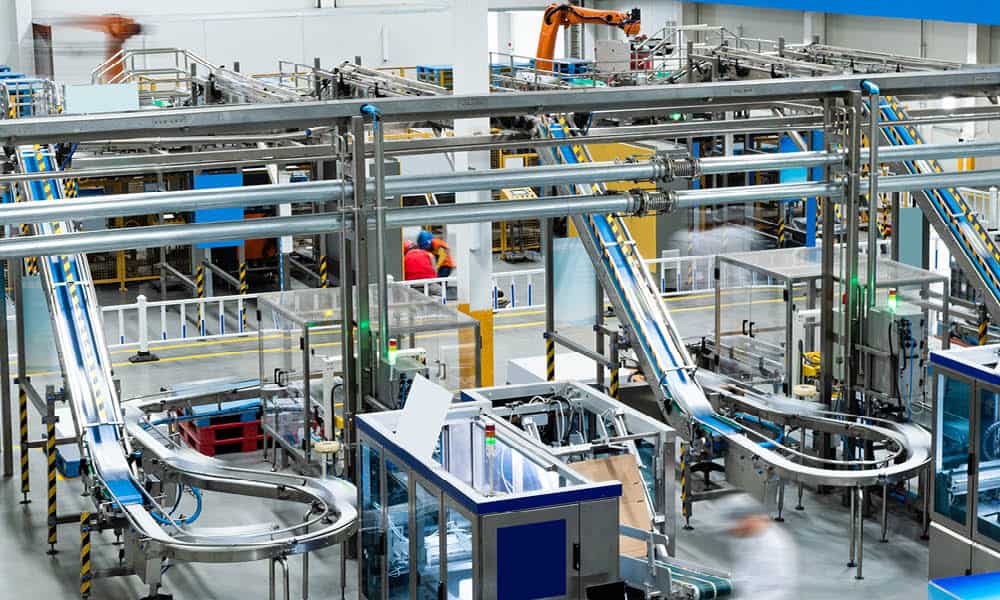
Product design, processes and partnerships optimize circularity to close the supply chain and manufacturing loop.

TAKEAWAYS:
● Consumers are demanding more circularity, so leading manufacturers are using circular models to reduce risk, unlock new revenue and build more resilient supply chains.
● Circular product design and digital twins are helping manufacturing optimize every lifecycle phase, from sourcing to end-of-life recovery.
● Collaboration across ecosystems is essential to scale circular operations and shared innovation.
What is a “Circular Economy” and why is it important now?
For more than 15 years, the Ellen McArthur Foundation has been working globally with businesses, academia, policymakers and institutions to accelerate the shift away from the traditional linear economy. As a global leader in this space, their definition of the core principles behind a circular economy are solid:
- Eliminate waste and pollution
- Circulate products and materials (at their highest value)
- Regenerate nature
All three are important, with the first two probably resonating the most with supply chain and manufacturing stakeholders. However, consumers are putting more pressure on organizations to focus equally on all three. This is part of why the circular economy today is an increasingly important topic; regardless of changing policy and regulation, the general global sentiment continues to drive buying behavior to brands and products that are focused on environmental stewardship.
Of course, pure operational issues are just as important, and that is what most of this article will focus on. Natural resources are being depleted at unsustainable rates, and governmental regulation (such as the EU’s Circular Economy Action Plan) are mandates that cannot be ignored. The circular economy has become a strategic imperative to compel manufacturers to rethink product design, operational models and value chain collaboration to maximize material value, reduce waste and regenerate natural systems.
Business case
Happily, implementing these core principles can unlock both economic advantage and sustainability leadership in increasingly resource-constrained (and competitive) markets.
Our previous linear model of “make-take-use-waste” was simple and efficient to follow, allowing for rapid industrialization and introduction of new products at low cost—a compelling list of benefits for manufacturers. However, while there are some additional costs in upfront investment in circular methods, many of the same benefits can still be realized while also achieving new sustainability and resiliency goals. For example:
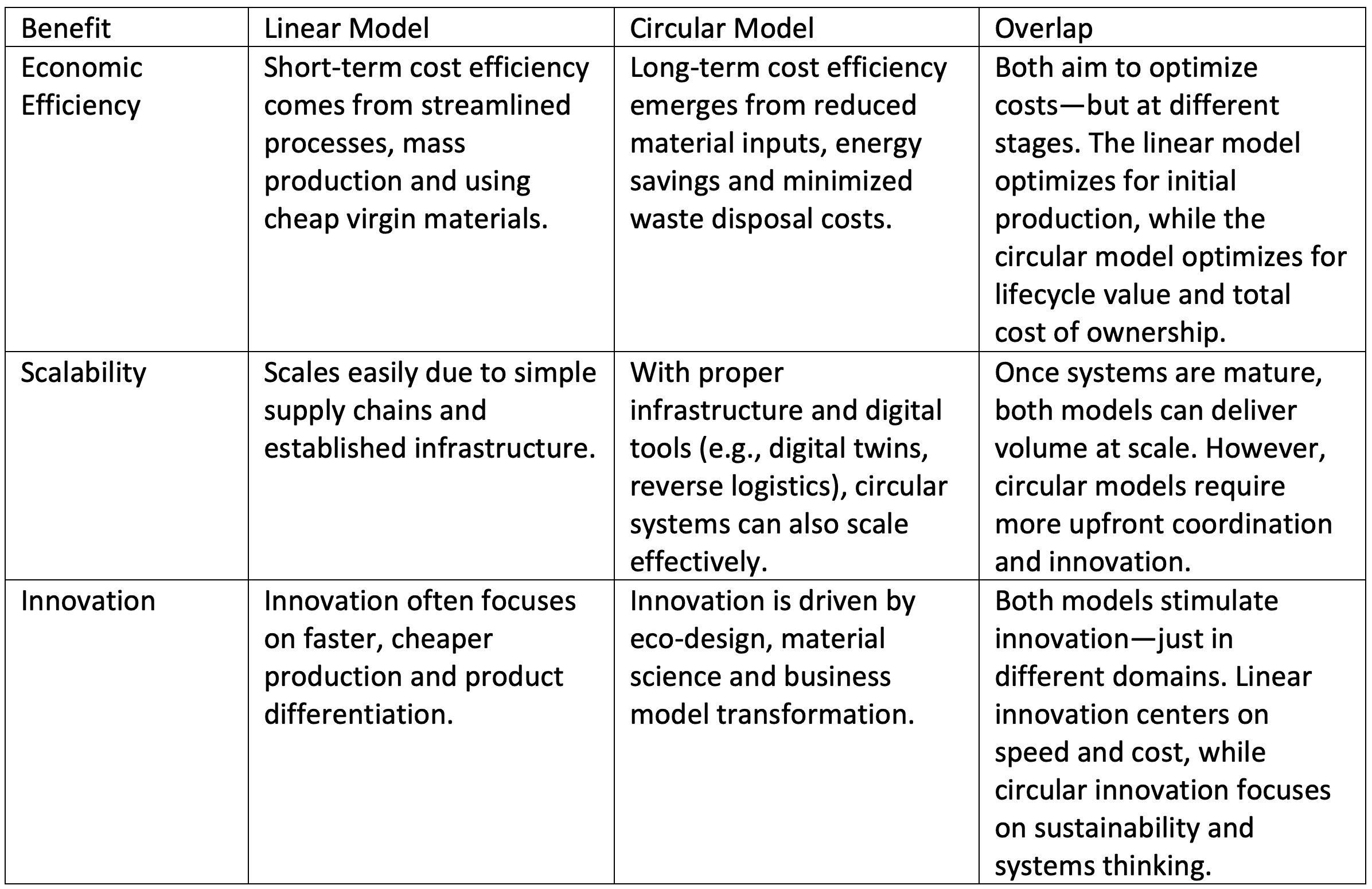
Although the results are similar, the drivers and (more importantly) the sustainability of the benefits are quite different. The linear model tends to focus on short-term benefit and is completely consumption-driven, compared to the longer-term benefit of the circular model, which is regenerative and systems-oriented.
In the last decade, there are many examples of companies, in all sorts of industries, developing new business models based upon this, such as HP’s closed-loop ink cartridge recycling, Caterpillar’s “Cat Reman” parts refurbishment, and Philips’ “lighting as a service” program.
Even disregarding mandates for change, the circular economy protects profitability and continuity by reducing dependency on volatile raw materials and turning waste into value. In short, it is not just good for the planet, it is a smart and resilient way to do business.
Key levers of change
There are many areas where manufacturers can start to transform operations from linear to circular. Each has pros and cons relative to the investment and outcomes, and many require collaboration across organizational departments and executive level commitment to change. However, they all represent areas where companies are already taking steps in leading the way to more sustainable operations.
1. Circular Product & Process Design
For most industries, this is the most important step to focus on. The vast majority of a product’s lifetime environmental footprint is “locked-in” during the design phase, long before the start of manufacturing.
Leading companies are focusing design efforts on durability and modularity during the “in-use” life of the product, and then disassembly and material separation at end-of-life. This has the potential to increase the cost and time attributed to design and engineering and might also increase manufacturing costs due to retooling. But there are also potential upsides for “long-tail” revenue related to spares or upgrade kits and, of course, the increasing brand equity with savvy consumers.
2. Responsible Material Sourcing & Substitution
The automotive Industry is a good example of historically straightforward supply chains becoming increasingly complex and dependent on rare-earth materials now that cars are becoming more electrified and electronic. Regulation on “responsible supply” is forcing manufacturers to put more focus on traceability of source and virgin raw materials.
Using supplier scorecards, manufacturers can see the impact of their sourcing decisions by the weighting of recycled content, renewable energy used in supply, and ethical and social responsibility of suppliers. Additionally, using AI to optimize supply based upon these criteria, manufacturers can lower exposure to supply volatility while also achieving higher gains in sustainability.
3. Zero-Waste, Resource-Efficient Operations
In metals and other heavy-industry segments, energy and materials represent a majority of the manufacturing costs of finished goods. Every kilogram of scrap is lost margin and an unnecessary increased environmental footprint.
Innovation in lean and digital manufacturing, and the use of next-generation manufacturing operation management systems, can have a dramatic impact on production quality and efficiency. Also, optimal scheduling of energy-intensive processes (heat treatment, ovens, etc.) can increase OEE while still maintaining customer service levels. These methods will likely require new investment in process controls and technology but deliver immediate cost reduction and sustainability benefits when in place.
4. Remanufacturing & Refurbishment Loops
There is still heavy debate about exactly how “green” EVs are. It should be noted, however, that this is a good industry to highlight the potential of remanufacturing. Tesla had a vision of old cars driving into one side of a factory and being refurbished into new cars driving out the other. While not quite a reality, most of the materials inside battery cells are recycled and repurposed, and restoring other types of industrial equipment can preserve up to 85% of the embedded material and energy, while also reducing new manufacturing costs and enabling potentially high-margin aftermarket business.
By implementing reverse flows of core material, building dedicated tear-down lines and requalification processes, manufacturers could see up to 65% cost savings in material. Additionally, while recycled inventory might be more uncertain, the benefit of near-zero lead times for supply could be substantial.
5. Reverse Logistics & Take-Back Infrastructure
The circular economy requires a circular logistics flow, and manufacturers need reliable ways to retrieve the products and materials at their end-of-life stage. For consumer products, there is the opportunity to provide drop-off kiosks or stage repair hubs at strategic locations. Alternatively, partnerships with existing carriers and 3PLs might provide easy ways for the return of salvageable items. It is also possible for manufacturers that own distribution to find ways to fill truck space without adding new logistics capacity.
Even with “coincidental” logistics capacity, there will be an increase in collection and handling costs, but also an opportunity to provide additional material feeds and stock via remanufacturing and refurbishment lines. This is also another highly visible area of operations that helps boost brand loyalty with consumers.
There are other, more transformational areas, such as new business models (product-as-a-service and sharing models) where manufacturers retain ownership of their assets. These methods are self-reinforcing because the profit incentive shifts from selling more units to maximizing asset life and recovery. This therefore drives further investment in better product and process design.
The other thing to consider is the dependency and symbiotic value of these areas. For example, better product design greatly improves the efficiency of remanufacturing. Similarly, better manufacturing operations can help with history and traceability of component materials for end-of-life reuse and refurbishment. Manufacturers should look at these as a total playbook that works together instead of as isolated initiatives.
Digital twins
Technology advances have greatly aided the circular economy’s scope and reality. In particular, the digital twin has become pivotal in developing digital models of products, production systems and supply chains.
The circular economy (like any new process) takes time and experimentation by manufacturers to turn ideas into reality. Digital twins have become the virtual universe where manufacturers can rapidly explore the art of the possible for new circular design, manufacturing and supply chain models.
Referring back to the previous example of circular product design, the digital twin of the product provides engineers unlimited ability to design products not only in the context of efficient manufacturing but also for efficient supply, re-manufacturing and disassembly. Manufacturers can compare dozens of different designs, integrated with the impact on sustainability, supply and production facilities, in hours instead of months. No previous generation of CAD/CAE has been able to orchestrate the processes that exist across the entire product lifecycle.
Because the digital twin represents the product and materials in precise detail, it is possible to experiment with modular design architecture and simulate how easily components can be removed and replaced. It is also possible to experiment with different materials that are recycled, using simulation to determine if the product strength and specs can still be achieved without using virgin-materials. Many manufacturers are already using digital twins for the “virtual build” process to validate manufacturability, so why not use the same process for “virtual disassembly” to ensure the material value can be reclaimed effectively at end-of-life?
The other significant capability of the digital twin is that it digitally documents the lifecycle of the product, using real-world data to help support circular methods and processes:
- Bill of Materials: to enable accurate sorting, recycling and reverse logistics
- Material Metadata: to highlight hazardous content, carbon footprint and compliance data
- Design Intent: to support virtual disassembly and remanufacturing
- Work Instructions: for both assembly and disassembly efficiency and safety
- In-Service Data: guides refurbishment and resale valuation
- Serial-Level Data: to support warranty management, digital passports and second-life usage
Besides the digital twin of the product, the digital twin of the production systems also contributes to the circular economy—especially in the area of waste and energy.
To evaluate new manufacturing methods that might be needed for different product designs or for recovery and disassembly, manufacturers can precisely simulate machinery, lines or entire facilities using precision virtual models to mitigate the risks involved in change. The level of detail in these models can include potential energy requirements, predictive maintenance that could reduce scrap and rework, and manufacturing process simulation to optimize the build and remanufacturing processes.
Without digital twins, true circular optimization across the entire product lifecycle would be impossible. The twin turns circular design from “best guess” to data-driven decision-making.
Making the circle bigger
Most of the previous examples are written in the context of what a manufacturer, alone, could consider or implement in its own business, but as manufacturers start to develop their own strategies, it is possible to see how new ecosystems could be formed, and provide benefits in different areas.
Shared Investment
Part of the circular ecosystems’ benefit is that some of the investment can be shared. Processes like reverse logistics can be particularly costly, and developing partnerships with shared infrastructure reduces per-unit costs and emissions and also improves route optimization and asset utilization.
For common materials, the cost of recycling processes can also be shared by manufacturers to reduce the need for individual capital investment.
Shared Resiliency
Circular networks are inherently less dependent on linear flows that are vulnerable to disruption (especially in global supply chains). Having nearby material flows enables manufacturers to operate more locally and develop better agility against change. That is also true for local disruption—for example, collaborative reverse logistics ensure material flow even if one node of the network is disrupted.
Generally, keeping materials “in-network” reduces the reliance on volatile global markets and enhances self-sufficiency. By collaborating and pooling within the network, all members benefit from a more resilient supply chain.
Shared Innovation
Remember the saying: “One person’s trash is another person’s treasure”? Cross-industry material flows are already a key part of the circular economy with many examples:
- Sugar cane waste -> bio-polyethylene for soda bottles
- Spent brewery grain -> livestock feed and skincare additives
- Recycled textiles -> natural fibers in car interiors
But shared innovation goes beyond making use of the known, it enables manufacturers to partner with different types of external businesses to collaborate on the design of products specifically developed for new circular economies. Shared innovation also leverages shared platforms that manage remanufacturing and resale and can share data tracking to help with regulatory compliance across industries.
Together, organizations can truly help to shape new business models and set standards on material tracking, digital passports and other innovation that helps everyone in the industry, while also promoting a company and its brand as a global leader.
Conclusion
There is a lot that manufacturers can do. Unlike innovation in digital manufacturing, where ROI has been documented and proven for a decade, circular economy initiatives can be more uncertain. The ROI can be a little “softer,” and moving from traditional linear models means tough changes in culture, process, systems, manufacturing and supply chains.
Manufacturers are not yet forced to move from the linear model, but the growing call for sustainable industrial operations is making it compelling for many, with increasing regulation and sentiment making it an urgent priority for some.
For those that are innovating, the benefits can be significant. Industry examples are helping to make the ROI more tangible and credible, and more companies innovating means more opportunities for collaborative ecosystems of circular economies.
As a key enabler, digital twin technology provides the tools for manufacturers to simulate and optimize every scenario and opportunity in the circular model. Many manufacturers embarking on the journey are facing new decisions and trade-offs between traditional operational metrics and sustainability metrics that they have likely not tracked before. The digital twin is the universe where unlimited questions can be asked and precise, rapid answers are given.
Finally, it is important to remove one’s business hat for a moment and focus purely on the third core principle of “regenerating nature.” After all, this is where the circular economy originated. It is much easier to be wasteful and consumptive, but there should be concern about the future generations that will inherit the results of decisions that are made today. The natural world faces increasing strain on land, air and oceans. Circular practices not only reduce harm, they aim to do more good. By regenerating soils, protecting biodiversity and enabling companies to operate in harmony with natural systems, conditions are created where business, humanity and the planet can all thrive.
To hear more on creating new value chains and optimizing material flows, listen to a brief “ask the expert” video from Dassault Systèmes, or even experience an interactive workflow that shows how optimized supply planning can enable sustainable operations. M
About the author:

Adrian Wood is strategic business development and marketing director for Dassault Systèmes.
Digital Tools for Manufacturing Resilience

Investments in technology can help manufacturers navigate economic uncertainty and geopolitical challenges

TAKEAWAYS:
● Despite economic uncertainty, tech spending is rising. Some U.S. manufacturers are increasing their investment in cloud, GenAI, 5G and other technologies to drive ROI and resilience.
● Digital tools are helping to build resilience. Supply chain planning software and simulation technologies are helping manufacturers optimize processes and adapt faster.
● Workforce strategies are increasingly going digital. New tools support digital talent management and targeted upskilling.
Some U.S. manufacturers have continued investing in digital technologies over the last several years despite economic uncertainty, rising costs and a challenging business climate. For instance, technology investments made by manufacturing companies accounted for 30% of their operating budget in 2024, compared with 23% in 2023, with cloud, GenAI and 5G being the top three technologies with the greatest ROI.
Furthermore, some manufacturers are increasingly turning to digital tools to help enhance resilience, improve supply chain visibility and address workforce needs, which could be particularly important in the current dynamic environment. According to Deloitte’s 2025 Manufacturing Industry Outlook, manufacturers anticipate a complex business climate for the remainder of 2025 due to high costs, potential policy changes following global elections and the potential for ongoing geopolitical uncertainty. Raw material costs are expected to rise further, and policy shifts related to trade, tariffs and adjustments to legislation could impact supply chains and investments. Digital technologies have emerged as tools to help navigate these complexities, including in these three areas:
- Supply chain planning and visibility
- Simulation
- Workforce management
Supply Chain Planning and Visibility
Manufacturers are expected to face continued supply chain risks, disruptions, potential delays and elevated costs due to several contributing factors. Ongoing labor shortages from production to transportation to warehousing could contribute to delays and higher costs throughout the value chain. Rising input costs and potential trade policy changes further complicate supply chain management. In recent years, these and other factors have led some organizations to shift their supply chain strategy from cost minimization to balancing cost optimization with resilience. To help achieve this, several manufacturers have reconfigured their supply chains by reshoring portions of their production, nearshoring and growing trade with countries offering cost advantages.
Focused investment in digital tools that enable advanced supply chain planning techniques, better collaboration with suppliers, simulation and enhanced visibility may provide an additional boost. In a recent study, 78% of manufacturers surveyed indicated that they have implemented or are planning to invest in supply chain planning software.
Partnering closely with suppliers, which digital tools can help support, may also be important to increase domestic capacity and improve resilience. Not only can it facilitate knowledge transfer and enhanced visibility, but it could be particularly important in cases where suppliers need to make investments in new technology, equipment, workers or even expand their facility. In a similar vein, industry leaders are expected to evolve their digital applications for supply chain visibility to resolve issues ranging from parts and labor shortages to concerns with quality and reliability of parts.
Simulation
The use of simulation in the manufacturing industry could also continue to grow, especially given the potential for business disruptions, the need to control costs, and the continued proliferation of AI tools. Simulation technologies such as causal AI can support production line simulation, process simulation and business scenario simulation, which appear to be increasingly important for optimizing workflows, reducing bottlenecks and enhancing decision-making.
For instance, business scenario simulation allows manufacturers to use an enterprise model to simulate challenges—such as employee absences, raw materials that arrive with quality issues and supply chain disruptions—and identify potential actions to optimize the response. The AI/ML and digital revolution can also help to revamp sustainment and aftermarket practices, with an emphasis on enhancing both operational efficiency and customer experience.
Upskilling and Retaining the Workforce Necessary to Support Reshoring
The makeup of the U.S. manufacturing industry, with its increasing focus on advanced manufacturing and push toward smart operations, requires technical expertise and advanced training. A 2024 study conducted by Deloitte and The Manufacturing Institute found that roles that require higher-level skills could grow the fastest between 2022 and 2032, and that a combination of technical manufacturing, digital and soft skills will likely be required. The study also underlines the role of digital tools to help meet workers’ changing expectations, reduce turnover and plan for demand volatility.
Companies seem to be increasingly focusing on leveraging digital tools that offer advanced talent planning and workforce management capabilities. These tools can also support manufacturers taking a skills-based approach, which may be increasingly important for broadening the talent pool. AI-based management of employee skills and deployment is emerging as a core capability, utilizing skills matrices and demand forecasting to optimize workforce planning and identify upskilling needs. A recent study indicates that by 2030, AI-based management of employee skills and how people are deployed to meet business needs will be a core capability. If gaps are identified, companies could offer upskilling opportunities for existing employees, which can increase retention, or work within the talent ecosystem to find and develop workers with the requisite skills. Taking this approach could also enable tailored upskilling that helps prepare employees for future work, for example, working alongside advanced technology such as GenAI.
Conclusion
Manufacturers are expected to navigate a challenging and uncertain business climate in 2025 due to high costs, potential policy changes from global elections, and continued geopolitical uncertainty. Focusing on supply chain visibility, simulation and digitally enabled workforce strategies can help companies build resilience, optimize operations and work toward competitiveness for the remainder of 2025 and beyond. By strategically leveraging digital tools, manufacturers can turn challenges into opportunities and position themselves for success in a changing industrial landscape. Moreover, digital transformation, automation and smart operations can help with cost reduction and may be important to offset potential impacts of tariffs. M
About the authors

Kate Hardin is the executive director of Deloitte’s Research Center for Energy and Industrials.

John Morehouse is the research leader for industrial products manufacturing in the Deloitte Research Center for Energy & Industrials.

Kruttika Dwivedi is a manager for the Deloitte Research Center for Energy and Industrials.

Anuradha Joshi is a senior research analyst at the Deloitte Research Center for Energy & Industrials.
This article contains general information only and Deloitte is not, by means of this article, rendering accounting, business, financial, investment, legal, tax, or other professional advice or services. This article is not a substitute for such professional advice or services, nor should it be used as a basis for any decision or action that may affect your business. Before making any decision or taking any action that may affect your business, you should consult a qualified professional advisor.
Deloitte shall not be responsible for any loss sustained by any person who relies on this article.
Why Smart Manufacturers Are Betting on Sustainability
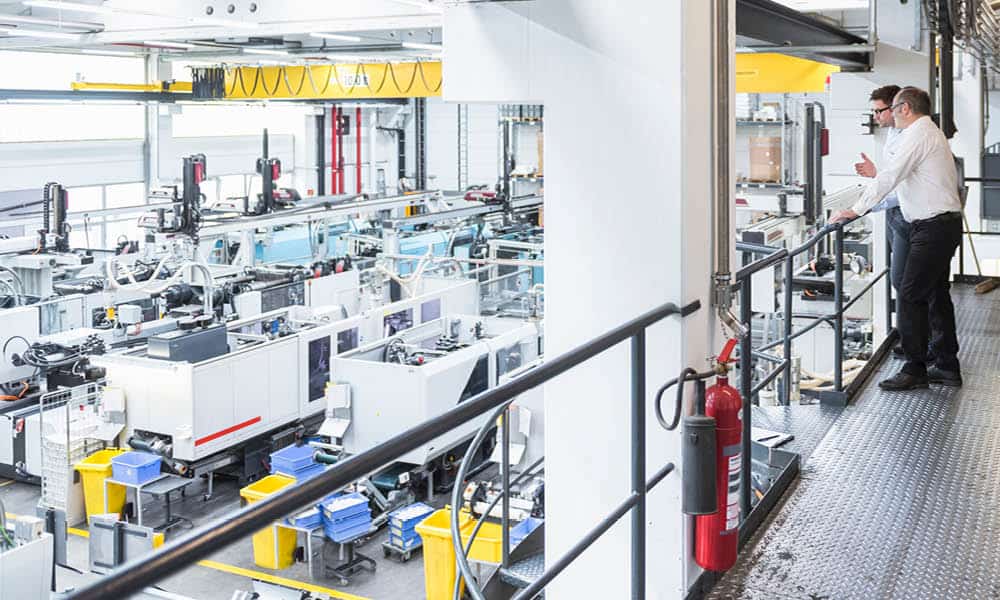
Industrial leaders are turning to digital technologies to drive profits and cut emissions.

TAKEAWAYS:
● Advanced technologies enable manufacturers to make informed, data-driven decisions that promote sustainability and energy savings.
● Sustainability in manufacturing involves reducing emissions and waste while creating business models that ensure long-term resilience.
● Manufacturers that embed sustainability into their business growth strategies will surpass their competitors.
The mandate is clear: manufacturers must become more efficient, resilient, and sustainable—all at once. This challenge collides with new opportunities as emerging technologies provide the means to transform operations, reduce waste, and gain visibility across the value chain that was not possible in the past. As a result, sustainability is becoming a priority in industrial operations and digital transformation agendas.
In a recent Kalypso survey of sustainability executives, 96 percent indicated that digital transformation is essential for meeting their environmental goals, with nearly half describing it as business-critical.
Technology as a Catalyst for Sustainability
Technologies such as artificial intelligence (AI), machine learning, and advanced analytics are enabling manufacturers to optimize resource use, increase throughput, and reduce emissions—all while enhancing operational performance.
Implementing these technologies can yield several improvements:
- Streamlined production processes
- Increased volume with less energy
- Retention of more raw materials
- Gained insights on consumption and output
These advancements not only lead to significant energy savings but also create a pathway for achieving greater sustainability through smarter, data-driven decisions.
Demystifying Net Zero
Net zero refers to the balance between the amount of greenhouse gases (GHGs) produced and the amount removed from the atmosphere (Figure 1).
Figure 1: What are Scope 1, 2, and 3 Emissions?

The Greenhouse Gas Protocol categorizes GHG emissions into three categories:
- Scope 1: Direct emissions from owned or controlled sources such as fuel combustion and company vehicles.
- Scope 2: Indirect emissions from the generation of purchased electricity, steam, heating, and cooling consumed by the reporting company.
- Scope 3: Indirect emissions from purchased services and materials, including raw materials, components, and consumables.
Reducing emissions across all three categories requires end-to-end traceability, real-time data, and system-wide optimization—capabilities that only advanced digital technologies can deliver at scale.
Sustainability and the Digital Thread
A powerful enabler of this transformation is the digital thread, which provides a continuous flow of data connecting every stage of the product life cycle. By embedding sustainability into this thread, manufacturers can enhance visibility, traceability, and control throughout the value chain. This integration facilitates effective decarbonization across Scopes 1, 2, and 3.
Although the concept of the digital thread is not new, the technologies that support it—such as cloud computing, edge computing, and AI—make energy savings more attainable and scalable than ever before. Several key sustainability use cases enabled by these technologies are illustrated (Figure 2).
Figure 2: Digital Thread Powering Sustainability

Case Study: Impactful Smart Facilities Management
In the quest for more efficient energy management, integrating IT and OT systems has proven to be a game changer. Smart building technologies optimize energy usage, leading to significant reductions in energy costs. Let’s examine an example from our collaboration with a major steel manufacturer to enhance its utility system and relieve pressure on its energy grid.
Previously, the company’s data collection method was tedious and manual. It involved downloading information from meters and the utility company, then correlating it with historical data and hypotheses based on past research. This backward-looking approach was not only time-consuming but also limited the company’s ability to derive actionable insights.
Recognizing the need for a more dynamic solution, we assisted the steel manufacturer in transitioning to a smart facilities management system. This new approach involved deploying a real-time energy management system that meticulously tracked the generation and consumption of water, air, gas, electricity, and steam (WAGES) across the plant. The redesigned infrastructure provided real-time insights that enabled the company to optimize energy usage, reduce costs, and ensure that production line assets operated efficiently and at full capacity.
The steel manufacturer realized several benefits:
- The real-time data allowed for immediate adjustments and optimizations, leading to a more responsive and efficient energy management process.
- It was able to identify and address inefficiencies promptly, resulting in substantial cost savings.
- The improved performance of production line assets contributed to a smoother and more reliable operations, further enhancing overall productivity.
The manufacturer attributed its improved performance to financial benefits and a positive return on investment. This case study underscores the transformative impact of smart facilities management and the critical role of IT/OT convergence in driving energy efficiency and cost savings.
Creating Sustainable Business Models and Ecosystems
The push for sustainability in manufacturing and across the value chain is not just about reducing emissions or waste; it’s also about creating business models that support long-term resilience and growth. A sustainable business model requires a holistic approach that considers environmental impact alongside economic and social factors.
Circular business models design products and operations for reuse, recycling, and remanufacturing, with the goal of keeping materials in circulation for as long as possible.
Digital technologies play a central role in this transition. AI and data analytics can pinpoint inefficiencies, predict maintenance needs, and guide product design for easier disassembly or reuse. Machine learning can help identify new opportunities for circular innovation.
Digital Transformation and Sustainability
Digital transformation and sustainability are no longer separate agendas; together, they are reshaping how industrial businesses create value. The convergence of AI, cloud computing, edge computing, and data analytics allows manufacturers to optimize production, reduce emissions, and improve margins.
Sustainability isn’t just about compliance or brand reputation; it’s about cost optimization, operational agility, and growth.
In the critical pursuit of net-zero goals, the technology integration is transforming industrial operations, improving efficiency, and reducing waste and emissions. By using tools like machine learning and data analytics, manufacturers can optimize resource use and streamline production, leading to energy savings and better material retention. Advanced digital technologies also enhance visibility throughout the supply chain, helping organizations decarbonize across Scopes 1, 2, and 3, and attain compliance with emerging regulations such as the Digital Product Passport.
The time to get started is now. Companies that address sustainability’s role in their business growth will outpace the competition. M
About the authors:

Rodrigo Alves is senior manager and lead of Kalypso’s Energy Management and Sustainability services.

Austin Locke is principal and global lead of Kalypso’s Data Science practice.
In Mexico, Schneider Electric Showcases “Lighthouse” Accomplishments
 Founded in 1836 when two brothers, Adolphe and Joseph-Eugene Schneider, took over the Le Creusot foundry in Burgundy, France, Schneider Electric today is a €38 billion energy management and automation provider with 150,000 employees doing business in more than 100 countries.
Founded in 1836 when two brothers, Adolphe and Joseph-Eugene Schneider, took over the Le Creusot foundry in Burgundy, France, Schneider Electric today is a €38 billion energy management and automation provider with 150,000 employees doing business in more than 100 countries.
The company manufactures its broad array of electrical and automation products at 200 factories around the globe, seven of which have achieved the distinction of being awarded World Economic Forum Lighthouse status. The WEF Lighthouse program measures adoption of advanced 4IR technologies, the financial and operational accomplishments, and its set of transformation enablers. There are 189 Lighthouses worldwide.
Approximately 100 Manufacturing Leadership Council members and guests toured one of Schneider Electric’s Lighthouse facilities earlier this month in Monterrey, Mexico. Known as Monterrey Plant 1, the seven-year-old, 450,000-square foot facility makes, warehouses, and distributes electrical products such as circuit breakers, panel boards, and numerous electrical distribution products.
The Monterrey factory’s digital management backbone is Schneider’s EcoStruxure platform, described by the company as an open, Internet-of-Things-based system that combines embedded connectivity, intelligence, and standard communication protocols to generate operational data, analyze that data, and make control decisions.
The EcoStruxure system has enabled the Monterrey plant to reduce downtime by 25% while achieving a 29% reduction in energy consumption. Schneider Electric says the Monterrey factory is the first factory in Mexico to achieve zero waste to landfill. The factory’s sustainability effort is part of Schneider Electric’s corporate goal to achieve Net Zero by 2050.
The tour for MLC members consisted of 10 stops on the factory floor. At each stop, Schneider Electric team members explained how they work, the systems they use, and how their particular work area fits into the factory’s overall flow. Among these stops, visitors witnessed data center resiliency, the company’s Lean Digitization System, deep learning vision for quality, IoT and machine learning for metal finishing operation uptime, and standardized MES for panel board assembly operations. Advanced MPH was also on display with the use of drone technology for warehouse cycle count and AGV utilization.
After the tour, a panel discussion with plant management, moderated by MLC, was held to allow MLC members to ask questions about what they had seen on the plant floor. Breakout sessions on brownfield plants, the Schneider supply chain, and the WEF’s Lighthouse program were also held during the day.
The MLC’s next plant tour will take place at United Scrap Metal on August 12-13, 2025 in Cicero, Illinois. Register for this tour and learn more about all of MLC’s plant tours: https://manufacturingleadershipcouncil.com/event/plant-tours.
About the Authors:
David R. Brousell is founder, vice president and executive director of the Manufacturing Leadership Council
Steven Moskowitz, Ph.D., is the senior director, event content at the Manufacturing Leadership Council.